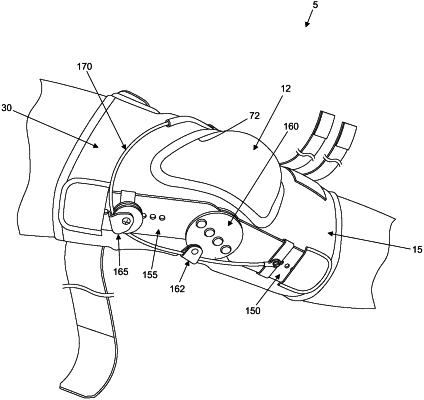| CPC A61F 5/0123 (2013.01) [A61F 2005/0167 (2013.01); A61F 2005/0176 (2013.01); A61F 2250/0073 (2013.01)] | 20 Claims |

|
1. An anatomical brace for dynamically stabilizing a patella during knee articulation so as to address patella tracking error, said anatomical brace comprising:
a brace body comprising:
a distal band having a first end, a second end and a fastener for securing together said first end of said distal band and said second end of said distal band;
a proximal band having a first end, a second end and a fastener for securing together said first end of said proximal band and said second end of said proximal band;
a medial connector having a distal end and a proximal end, said distal end of said medial connector being connected to said distal band and said proximal end of said medial connector being connected to said proximal band;
a lateral connector having a distal end and a proximal end, said distal end of said lateral connector being connected to said distal band and said proximal end of said lateral connector being connected to said proximal band;
said distal band, said proximal band, said medial connector and said lateral connector together defining a central opening sized to receive the patella of a patient;
a hinge mechanism comprising a distal segment, a proximal segment and a pivot for pivotally connecting said distal segment and said proximal segment, said distal segment of said hinge mechanism being connected to said distal band and said proximal segment of said hinge mechanism being connected to said proximal band;
a first cable guide mounted to said pivot;
a second cable guide mounted to said proximal segment of said hinge mechanism;
a third cable guide secured to said lateral connector;
a cable having a first end and a second end;
said first end of said cable being mounted to said distal segment of said hinge mechanism, said second end of said cable being mounted to at least one of said distal band and said lateral connector, and said cable being routed proximally along said distal segment of said hinge mechanism, through said first cable guide, proximally along said proximal segment of said hinge mechanism, through said second cable guide, laterally along said proximal band, distally along said lateral connector and through said third cable guide;
wherein, when said anatomical brace is mounted to a knee of a patient so that said distal band is secured to a calf of the patient, said proximal band is secured to a thigh of the patient and the patella of the patient is received in said central opening of said brace body, and when the knee thereafter moves to full extension, said cable is tensioned, whereby to apply a proximal/medial force to the patella of the patient, and when the knee thereafter moves to full flexion, said cable is relaxed, so that the proximal/medial force is released.
|